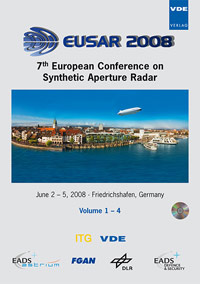Near Real Time SAR Processors for ISRO’s Multi-Mode RISAT-I and DMSAR
Conference: EUSAR 2008 - 7th European Conference on Synthetic Aperture Radar
06/02/2008 - 06/05/2008 at Friedrichshafen, Germany
Proceedings: EUSAR 2008
Pages: 4Language: englishTyp: PDF
Personal VDE Members are entitled to a 10% discount on this title
Authors:
Kunal, Abhishek; Kumar, B. Saravana; Sharma, Ritesh Kumar; Kunal, Abhishek; Gameti, Ramesh B.; Gujraty, V. R. (MSDPD/MSDG/MRSA/SAC, Space Applications Centre (SAC), Indian Space Research Organisation (ISRO), Ahmedabad-380 015, India)
Abstract:
Indian Space Research Organisation’s (ISRO) developed an indigenous C-band Airborne Synthetic Aperture Radar (ASAR) in mid-1990s and operationalised it in early 2000. ASAR has since been replaced with the developmental model of an airborne SAR for Disaster Management (DMSAR). Similarily, India’s Radar Imaging Satellite-1 (RISAT-1) spaceborne SAR mission, scheduled for launch in 2009 AD, will also provide unique imaging opportunities and coverage patterns over India and all other regions of the earth. Flood mapping and disaster monitoring have been the major application areas of these airborne and spaceborne SARs, apart from other civilian and strategic applications. Considering that, the utility of SAR sensor is primarily governed by its capability to quickly generate radar images of the terrain under observation and mapping. Therefore, Onboard or On-ground Quick Look Real-Time SAR signal processing has been a standard feature of ISRO’s SARs. Because of the acute need of fast turn around times for SAR information and data products, we have evolved a reconfigurable Multi-Mode SAR Processor to meet the varied and complex quick look and near real time SAR processing requirements of RISAT-1 and DMSAR. A generic full-fledged hardware Near Real Time SAR Processor (NRTP) has been evolved, as Symmetric Multi-Processor (SMP) architecture based on multi-processor Analog Devices TigerSHARC TS101S/TS201S DSP plug-in boards on a Compact PCI (cPCI) workstation. NRTP consists of Range Processor, a Pre-processor for Motion Sensing computations and Motion Compensation, Azimuth Block processor and the Post-Processor. It performs data de-compression, buffer storage, re-formatting, two-dimensional SAR processing and motion compensation tasks and generates the final image on display monitor and stores SAR images on suitable recording media. The input-ingest to NRTP range processor is done through a RAID/JBOD recorder replay unit and a cPCI workstation with Single Board Computer (SBC) performs the overall control and coordination tasks for the various DSP processors and other interfaces. For DMSAR, this generic SAR Processor operates as a Quick Look SAR Processor (QLP) on-board the aircraft to produce real time full swath DMSAR images and as a ground based Near-Real Time high precision full swath Processor (NRTP). It will generate full-swath (6 to 75 Kms) DMSAR images in 1m / 3m / 5m / 10m / 30m resolution SAR operating modes. For RISAT-I mission, this NRTP will generate high resolution Spotlight SAR image (10x100 Kms), Stripmap SAR image (3m, 30x30 Kms) and ScanSAR images (25m, 120x120 Kms and 50m, 240x240 Kms) with real time quick look as well as 100 minutes near-real product turn around times. This paper describes the design requirements, high performance computing requirements, algorithmic and DSP architecture details, salient performance features, benchmark test results and DMSAR images generated using NRTP SAR processor.


